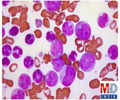Every acute myeloid leukemia (AML) patient has a common feature of aging called ARCH-age-related clonal hematopoiesis but not everyone with ARCH gets AML, stated study.

‘New method to predict healthy individuals at risk of developing acute myeloid leukemia (AML), an aggressive and often deadly blood cancer has been discovered.’





Dr. Dick is also a Professor, Department of Molecular Genetics, University of Toronto, holds the Canada Research Chair in Stem Cell Biology, and is Co-Leader of the Acute Leukemia Translational Research Initiative at the Ontario Institute for Cancer Research. Study author Dr. Sagi Abelson, a post-doctoral fellow in the Dick lab, says: "AML is a devastating disease diagnosed too late, with a 90 per cent mortality rate after the age of 65. Our findings show it is possible to identify individuals in the general population who are at high risk of developing AML through a genetic test on a blood sample.
"The ultimate goal is to identify these individuals and study how we can target the mutated blood cells long before the disease actually begins."
The study builds on Dr. Dick's 2014 discovery that a pre-leukemic stem cell could be found lurking amongst all the leukemia cells that are present in the blood sample taken when a person is first diagnosed with AML. The pre-leukemic stem cell still functions normally but it has taken the first step in generating pathway of cells that became more and more abnormal resulting in AML (Nature, February 12, 2014), and continues his quest to trace every step in the evolution of AML, starting with blood cells from healthy people.
"Our 2014 study predicted that people with early mutations in their blood stem cells, long before the disease appears and makes them sick, should be able to be detected within the general population by testing a blood sample for the presence of the mutation." says Dr. Dick.
Advertisement
The leukemia team extracted the data from more than 100 participants who developed AML six to 10 years after joining the study, plus the data from an age-matched cohort of more than 400 who did not develop the disease.
Advertisement
Furthermore, the team used advanced computational technology to assay the information obtained from routinely collected blood tests taken over 15 years in Israel and housed in a massive database of 3.4 million electronic health records.
The study has deepened our understanding of the distinction between AML and a common feature of aging called ARCH-age-related clonal hematopoiesis-whereby blood stem cells acquire mutations and become a little more proliferative. For the vast majority of people this is just a completely benign feature of aging.
Source-Eurekalert













